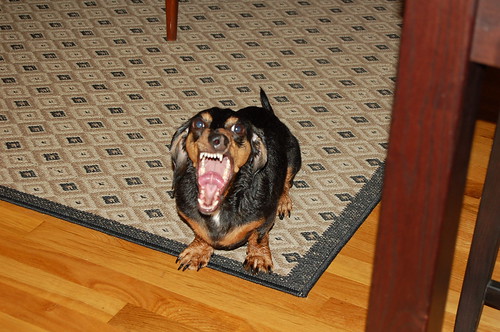
![]() I take a big issue with breed-specific legislation. Politicians target innocent breeds that they claim are "dangerous" because they're too small-minded to look at the facts of how dogs become aggressive. If you were to outlaw "dangerous" breeds, you'd have to start with the most aggressive - like Dachshunds, Chihuahuas, and Jack Russell Terriers. Pit Bulls don't even make the list - and have only ranked higher than 5th on the Vicious Animal Legislation Task Force's Reports once (in 1992, and were still below Cocker Spaniels). People are killed often by other breeds, including the ever-lovable Lab and even Pomeranians. Even the CDC does not support Breed Specific Legislation. But I digress. What's really important is that it's not the dog's breed that makes it aggressive, it's the dog's owner.
I take a big issue with breed-specific legislation. Politicians target innocent breeds that they claim are "dangerous" because they're too small-minded to look at the facts of how dogs become aggressive. If you were to outlaw "dangerous" breeds, you'd have to start with the most aggressive - like Dachshunds, Chihuahuas, and Jack Russell Terriers. Pit Bulls don't even make the list - and have only ranked higher than 5th on the Vicious Animal Legislation Task Force's Reports once (in 1992, and were still below Cocker Spaniels). People are killed often by other breeds, including the ever-lovable Lab and even Pomeranians. Even the CDC does not support Breed Specific Legislation. But I digress. What's really important is that it's not the dog's breed that makes it aggressive, it's the dog's owner.
That obvious conclusion was just scientifically supported by a new study out of the University of Pennsylvania. Using surveys, researchers investigated how different training behaviors related to aggressive behavior.
Dogs which were trained using aggressive methods tended to be more aggressive. Methods such as hitting, kicking, growling, physical force, or other intimidation tactics elicited aggressive behavior in at least 25% of the dogs who were subjected to them. And a large portion - 1/3 or more of owners - utilized such methods. But what's even worse is that the owners reported that these methods, though often used, were ineffective. In other words, not only did they use aggressive methods to try to curb bad behavior, but they didn't work.
.jpg) âOur study demonstrated that many confrontational training methods, whether staring down dogs, striking them or intimidating them with physical manipulation does little to correct improper behavior and can elicit aggressive responses,â said Meghan E. Herron, lead author of the study.
âOur study demonstrated that many confrontational training methods, whether staring down dogs, striking them or intimidating them with physical manipulation does little to correct improper behavior and can elicit aggressive responses,â said Meghan E. Herron, lead author of the study.
To avoid aggressive behavior, most trainers recommend positive reinforcement or neutral training means, which foster a loving relationship with your pet.
It also adds to the growing evidence that it's the owners, not the dogs, that are the problem. People buy and breed dogs to fight, and then wonder why their neighbor or friend ends up bitten (77% of dog bites are from the pet of family or friends). Or parents leave their kids alone with young, energetic dogs and wonder what goes wrong (upwards of 75% of attacks are against kids). Of course, this isn't the first study to show that it's not the breed that's the problem - others have, too - but this is the first to really directly connect training methods, even commonly used ones, to dog behavior. Hopefully people will start paying attention and instead of banning "aggressive" breeds, put in legislation that hold the owner responsible for their dog's behavior and exacts stiffer penalties out of people who are involved in dog fighting.
D DUFFY, Y HSU, J SERPELL (2008). Breed differences in canine aggression Applied Animal Behaviour Science, 114 (3-4), 441-460 DOI: 10.1016/j.applanim.2008.04.006
M HERRON, F SHOFER, I REISNER (2009). Survey of the use and outcome of confrontational and non-confrontational training methods in client-owned dogs showing undesired behaviors Applied Animal Behaviour Science, 117 (1-2), 47-54 DOI: 10.1016/j.applanim.2008.12.011
- Log in to post comments

